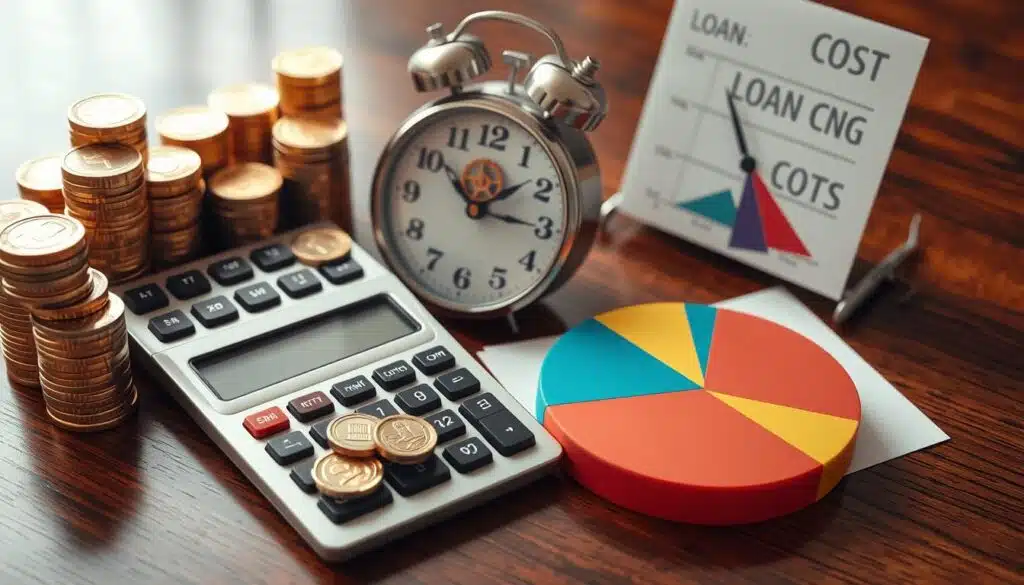Choosing the right loan term is key to managing your monthly payments and the loan’s total cost. This guide will help you pick the best loan term for your financial situation. We’ll look at common loan terms for various loans, how they affect your payments and interest, and when a shorter or longer term might be better. By understanding loan term length, you can make a smart choice and balance affordability with the loan’s total cost.
Key Takeaways
- Loan term length can significantly impact your monthly payments and the overall cost of the loan.
- Common loan terms vary based on the type of loan, such as personal loans, mortgages, and auto loans.
- Factors like loan amount, interest rate, and your financial situation should be considered when choosing the ideal loan term.
- Shorter loan terms usually result in lower interest costs, but higher monthly payments, while longer terms offer lower monthly payments but more interest paid over time.
- Determining the best loan term requires balancing your immediate financial needs and long-term financial goals.
Understanding Loan Term Length
When you borrow money, the loan term is key. It’s the time you have to pay back the loan. Loan terms change based on the loan type and the lender’s rules.
What Is a Loan Term?
A loan term is how long you have to pay back the loan. It’s the time you make regular payments to the lender until you’re done. Loan terms can be very short or very long, depending on the loan type.
Common Loan Terms for Different Types of Loans
Loan terms vary a lot across different loans:
- Mortgages usually last 10 to 30 years, sometimes up to 40.
- Auto loans have terms like 24, 36, 48, 60, 72, or 84 months.
- Personal loans are usually paid back in 12 to 60 months.
- Student loans have repayment periods of 10 to 25 years.
Knowing the typical terms for each loan type helps you pick the best one for your money situation and goals.
“The loan term is a critical factor in determining the overall cost of borrowing. Shorter terms typically result in lower interest costs, while longer terms can make monthly payments more manageable.”
Factors Affecting Personal Loan Terms

When you apply for a personal loan, many factors can change the term lengths and how they affect your budget. It’s important to know these factors to pick the best loan term for you.
How Term Length Impacts Monthly Payments and Interest Costs
The loan term’s length is a big factor in your monthly payments and total interest. Shorter terms mean higher monthly payments but less total interest. Longer terms have lower monthly payments but more total interest.
Loan Amount and APR Considerations
The loan amount and APR also affect the loan’s total cost. Bigger loans with higher rates mean more interest over time. Checking your credit, income, and debt ratio helps pick the best loan amount and term for your budget and goals.
| Loan Term | Monthly Payments | Total Interest Paid |
|---|---|---|
| 3 years | $300 | $1,800 |
| 5 years | $200 | $3,000 |
| 7 years | $160 | $4,500 |
This table shows how the loan term affects your monthly payments and total interest. By thinking about these factors, you can choose a loan that fits your budget and goals.
“Understanding the factors that influence personal loan terms is essential in finding the right balance between affordability and cost-effectiveness.”
Choosing the Ideal Loan Term

Choosing the right loan term is key when getting a personal loan. It should match your short-term and long-term financial needs. Think about the loan’s purpose, how you can pay it back, and your financial goals when picking a term.
When a Shorter Term Makes Sense
A shorter loan term is good if you want to pay off debt fast and save on interest. It’s great if you have a steady budget and can handle higher monthly payments. This is perfect for debt consolidation, improving your home, or big buys where you want to be debt-free quickly.
When a Longer Term is Preferable
- A longer loan term is good for big loans because it lowers your monthly payments. This makes it easier on your monthly budget.
- It’s also good if you can’t pay back much at once or if you’re saving for something big, like retirement. This way, your loan payments fit with your long-term financial goals.
- For things like fixing up your home or buying something big, a longer loan term lets you pay less each month. This helps you manage your money better.
Choosing between a shorter loan term or a longer loan term depends on your situation and what you need. Think about how you can pay back the loan, your budget, and your financial goals. This way, you pick the ideal loan term for you.
Loan Term and its Effect on Total Loan Cost

The loan term greatly affects the cost of personal loans. A shorter loan term might mean higher monthly payments. But, it can lead to lower total loan costs because of less interest costs. On the other hand, a longer loan term means lower monthly payments. But, you’ll pay more total interest over time, making the overall loan expenses higher.
Let’s look at an example. Say you’re borrowing $20,000 at a 10% APR. Choosing a 3-year loan term means your monthly payments are about $618. You’ll pay around $2,218 in total interest over the loan’s life. But, picking a 5-year loan term lowers your monthly payments to about $424. Yet, you’ll end up paying around $3,740 in total interest.
| Loan Term | Monthly Payments | Total Interest Paid | Total Loan Cost |
|---|---|---|---|
| 3 years | $618 | $2,218 | $22,218 |
| 5 years | $424 | $3,740 | $23,740 |
The way the loan is paid back and its amortization also affect the total loan cost. Knowing how the loan term impacts these can help you choose the best option for your budget.
“The right loan term can make a big difference in your loan’s cost. So, think carefully about the trade-offs between monthly payments and total interest paid.”
Also Read : How Creditworthiness Affects Your Financial Opportunities?
Conclusion
Choosing the right loan term is key to your financial health. It affects how you manage your money. Knowing about different loan terms and what affects them helps you pick the best one for your goals and budget.
Looking at personal loans, mortgages, or auto loans, think about the term, amount, and APR. This balance is crucial for keeping costs down. It lets you choose financing that fits your needs.
Think about how the loan term changes your monthly payments and interest costs. Also, consider your credit profile and what your lender likes. This way, you can pick a loan that helps your finances in the long run.
FAQs
Q: What is a term loan?
A: A term loan is a type of loan that is paid back over a set period, known as the repayment term. This can range from a few months to several years, depending on the loan agreement between the borrower and the lender.
Q: How do term loans work?
A: Term loans work by providing a lump sum of money to the borrower, which they must repay with interest over a predetermined length of the loan. The borrower makes regular payments that typically include both principal and interest, according to the terms and conditions outlined in the loan agreement.
Q: What should I consider when reviewing loan offers?
A: When reviewing loan offers, consider the interest rate, repayment term, any fees associated with the loan, and the lender’s terms and conditions. It’s important to compare different loan options to determine which loan is right for your financial situation.
Q: How does the interest rate affect my loan payment?
A: The interest rate directly affects the payment amount on your loan. A higher interest rate increases the cost of borrowing, leading to higher monthly payments, while a lower interest rate can result in more affordable loan payments.
Q: What is the difference between a short-term loan and a long-term loan?
A: A short-term loan typically has a repayment term of less than one year, while a long-term loan can last several years. Short-term loans often have higher interest rates but lower total costs, whereas long-term loans may have lower monthly payments spread over a longer period.
Q: How can I use a loan calculator to estimate my payments?
A: A loan calculator can help you estimate your monthly payments by inputting the loan amount, interest rate, and repayment term. This tool can provide you with an idea of how much you’ll need to repay each month and the total cost of the loan over its life.
Q: What are the terms and conditions of a loan agreement?
A: The terms and conditions of a loan agreement outline the specifics of the loan, including the interest rate, repayment schedule, fees, and any penalties for late payments or prepayment. It’s essential to understand these terms before signing the loan contract.
Q: What does a longer loan term mean for my finances?
A: A longer loan term can lower your monthly payment but may increase the total interest paid over the life of the loan. Borrowers should weigh the benefits of lower payments against the potential for higher overall costs when considering longer loan terms.
Q: How does my credit score affect my loan options?
A: Your credit score impacts the loan offers you receive from lenders, including the interest rate and terms. A higher credit score can lead to lower interest rates and better loan options, while a lower score may limit your choices and result in higher costs.
Q: What is the significance of the amortization schedule in a loan?
A: The amortization schedule outlines the breakdown of each payment into principal and interest over the life of the loan. Understanding this schedule helps borrowers see how much of their payment goes towards repaying the loan versus interest, which is crucial for financial planning





